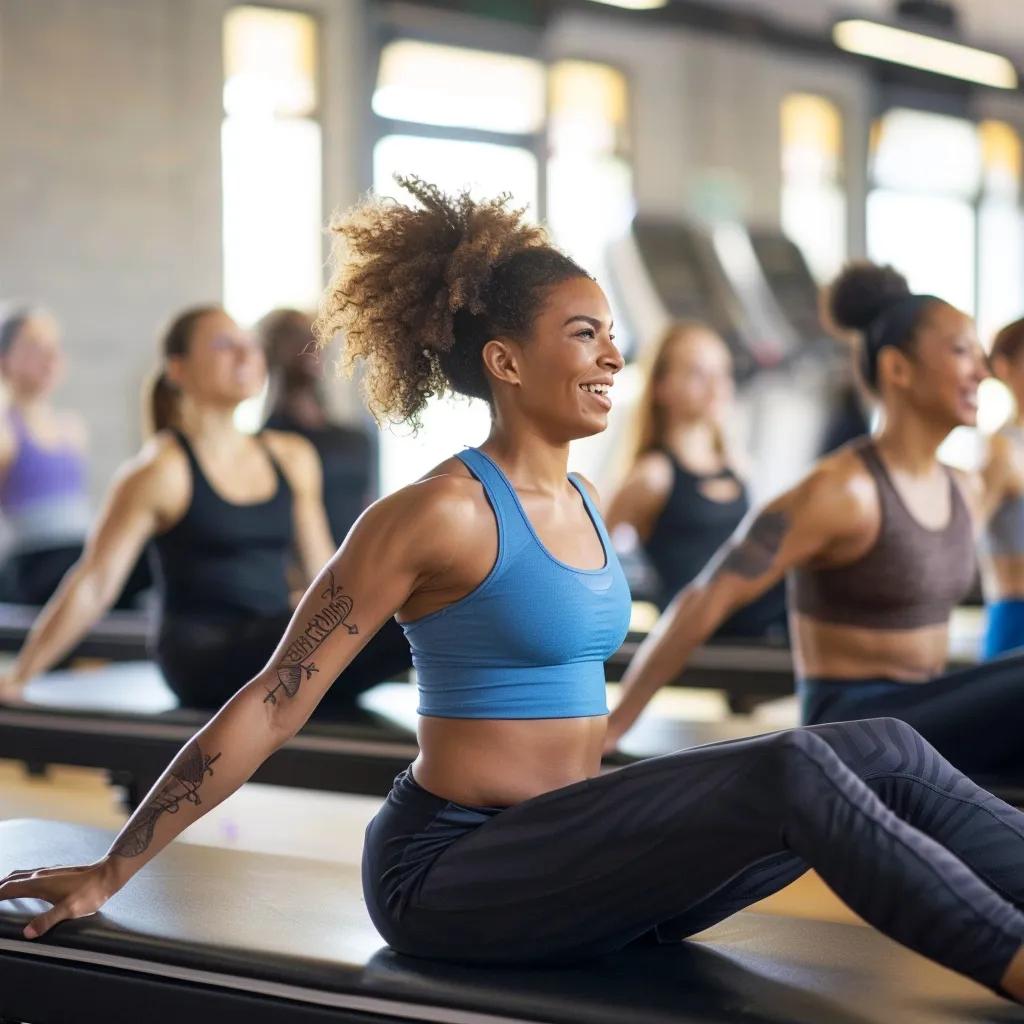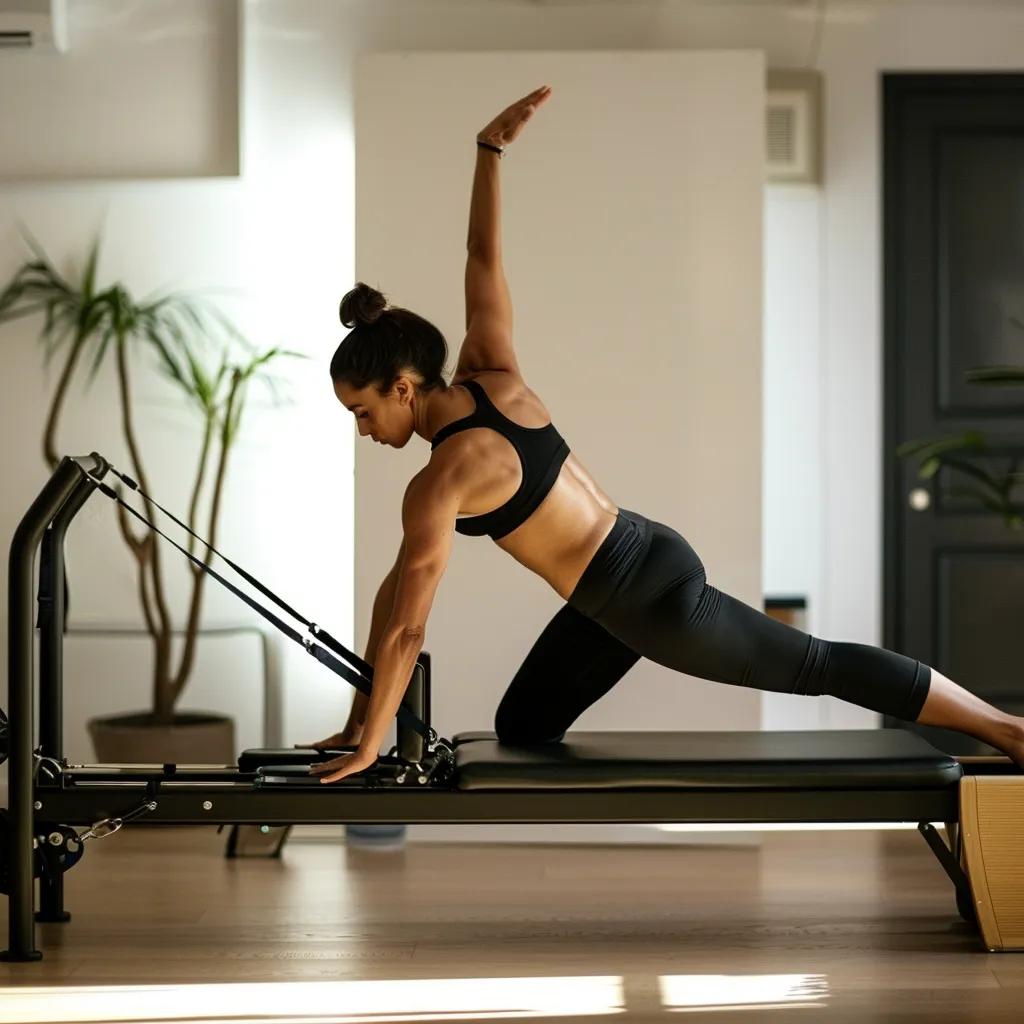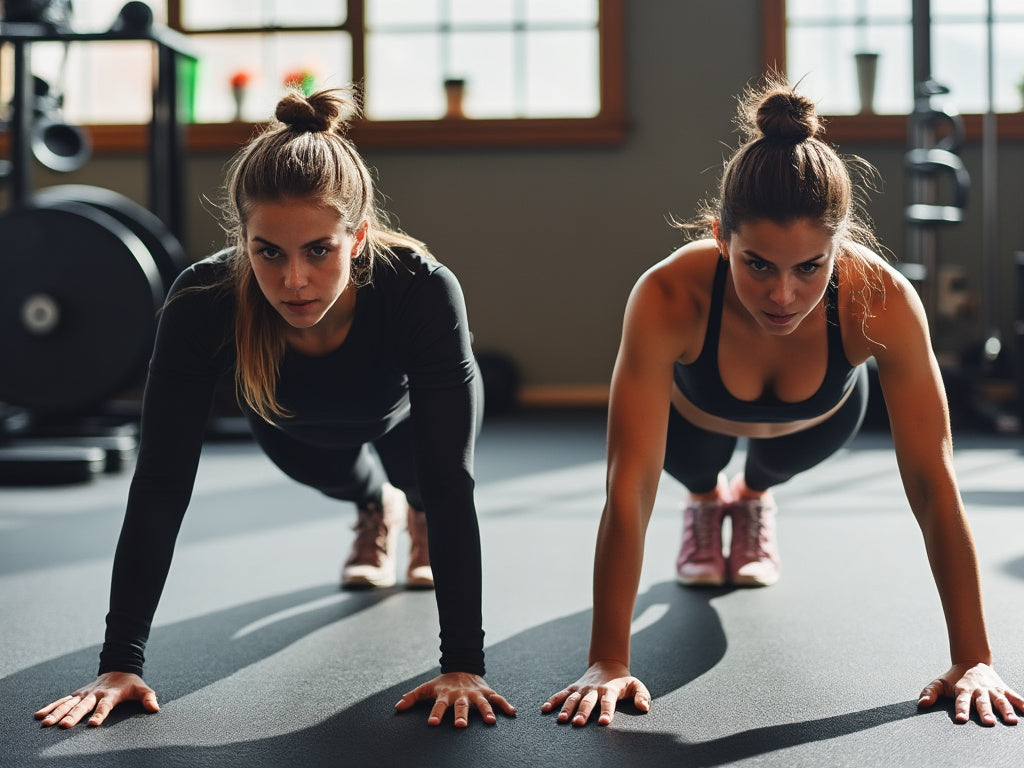The Transformative Power of Pilates in Your Fitness Journey

Imagine a workout that not only strengthens your core but also enhances your flexibility, improves your posture, and connects your mind and body. That’s Pilates for you. It’s the secret weapon against workout plateaus and those pesky aches that slow you down. By weaving Pilates into your routine, you’re embracing a low-impact, balanced approach that boosts your strength and keeps injuries at bay. Dive into this guide to uncover the magic of Pilates—how it fortifies your core, enhances flexibility, aligns your posture, prevents injuries, and sharpens your mental clarity. We’ll also explore who benefits the most, practical tips for integration, and key considerations to keep your momentum going strong.
Why Should You Add Pilates to Your Workout Routine?
Pilates is a gentle yet powerful exercise method that targets deep muscles through controlled movements. It enhances your stability and body awareness, delivering greater flexibility, improved posture, injury prevention, and a stronger mind-body connection with every session.
Here’s what you unlock when you embrace Pilates:
- Core Strength & Stability – Engage your transversus abdominis and pelvic floor for better balance.
- Flexibility & Mobility – Enjoy greater joint range of motion with dynamic stretches and spinal movements.
- Posture & Spinal Alignment – Correct imbalances and support healthy ergonomics with targeted postural muscles.
- Injury Prevention & Rehabilitation – Balanced muscle activation reduces strain and aids recovery.
- Mind-Body Connection – Focused breathing and concentration promote mental clarity and stress reduction.
Before we dive deeper into each benefit, think about how these elements come together to create a solid fitness foundation that elevates every other workout you do.
| Benefit | Mechanism | Outcome |
|---|---|---|
| Core Strength & Stability | Controlled, isometric holds activate deep core | Improved balance and reduced falls risk |
| Flexibility & Mobility | Dynamic stretching and spinal articulation | Greater joint health and fluidity |
| Posture & Spinal Alignment | Targeted scapular and pelvic cues | Decreased back strain and slouching |
| Injury Prevention & Rehabilitation | Balanced muscle engagement and corrective movements | Faster recovery and fewer strains |
| Mind-Body Connection | Coordinated breath-movement patterns | Reduced stress and heightened focus |
Each benefit builds on the last. Core stability enhances mobility, which supports proper alignment, leading to fewer injuries and a calm, focused mind.
How Does Pilates Boost Core Strength and Stability?

Pilates strengthens your core by engaging deep abdominal muscles through controlled flows and stabilization exercises, reinforcing spinal support and functional balance in daily movements. This foundation enhances your performance in weight training, running, and everyday tasks.
Precision is key in Pilates, ensuring that the transversus abdominis, multifidus, and pelvic floor work in harmony, creating a natural corset around your spine. This translates to solid posture, efficient force transfer, and a reduced risk of lower-back pain as you tackle more demanding activities.
How Does Pilates Specifically Build Core Strength and Stability?
Pilates combines isometric holds and dynamic stabilization exercises to engage the deep trunk muscles—transversus abdominis, multifidus, and pelvic floor—creating a supportive foundation for movement and posture.
This deliberate activation enhances torque control around the spine, leading to more efficient force production and reduced spinal load during lifting, running, or everyday bending.
Which Core Muscles Are Targeted by Pilates Exercises?
- Transversus abdominis for corset-like support
- Internal and external obliques for rotational stability
- Multifidus for intersegmental spinal support
- Pelvic floor for pelvic alignment and intra-abdominal pressure control
These synergistic contractions form a dynamic stability system that underlies all powerful, pain-free movements.
What Scientific Principles Explain Pilates’ Effectiveness for Core Stability?
At its core, Pilates leverages proprioceptive feedback and variable loading to stimulate deep neuromuscular pathways, strengthening the core’s postural muscles via repeated, controlled micro-adjustments. This mechanism enhances motor unit recruitment and intermuscular coordination, proven to increase trunk stiffness and reduce undesirable motion under load.
How Does Improved Core Strength Impact Daily Activities and Other Workouts?
A fortified core translates to safer lifting mechanics, more efficient running posture, and greater endurance in activities like swimming or cycling. The stability gained from Pilates reduces compensatory overuse of the lower back and hips, yielding better power transfer and longevity across all fitness pursuits.
What Evidence Supports Pilates for Core Strength Enhancement?
Clinical studies in the Journal of Bodywork and Movement Therapies show a 25–30% increase in core muscle activation after eight weeks of Pilates, while randomized trials report significant reductions in chronic low-back pain. These findings endorse Pilates as an evidence-based method for building lasting trunk stability.
Pilates and Core Muscle Activation
Research indicates that Pilates exercises significantly increase core muscle activation. Studies have shown a notable increase in core muscle activation after consistent Pilates practice, which can lead to improved trunk stability and reduced back pain.
Journal of Bodywork and Movement Therapies
This research supports the article's claims about the effectiveness of Pilates in strengthening core muscles and improving overall stability.
How Can Pilates Increase Flexibility and Joint Mobility?

Pilates increases flexibility by using spinal articulation, active stretching, and eccentric loading to lengthen muscles and mobilize joints, which improves functional range of motion and reduces stiffness. This comprehensive approach addresses both muscular and connective tissue adaptation for long-term mobility gains.
Which Joints and Muscle Groups Benefit Most from Pilates?
- Spine through articulate mat exercises
- Hips via leg springs and stretches
- Shoulders through controlled scapular movements
These targeted mobilizations promote balanced length-tension relationships, supporting injury-free alignment.
What Pilates Techniques Promote Greater Range of Motion?
- Spine Roll-Downs for vertebral flexibility
- Hamstring Stretches on the mat or Cadillac
- Shoulder Openers using reformer straps
Each technique integrates breath-driven movement to ease tissue tension and encourage neural relaxation.
How Does Enhanced Flexibility Improve Overall Fitness and Injury Prevention?
Greater flexibility allows muscles and joints to move through optimal paths, reducing compensatory patterns that lead to strains. In resistance training, increased joint mobility supports deeper squats and lunges, while in sports, it fosters fluid performance without abrupt stops or jerks.
What Research Validates Pilates’ Role in Flexibility Improvement?
Research published by the American Council on Exercise (ACE) demonstrates a 15–20% improvement in hamstring and shoulder range of motion after a 12-week Pilates regimen, underscoring its efficacy for sustained mobility enhancement.
Pilates and Flexibility Improvement
Studies have demonstrated that a Pilates regimen can lead to significant improvements in flexibility. Research has shown that regular Pilates practice can increase the range of motion in the hamstrings and shoulders, highlighting its effectiveness in enhancing mobility.
American Council on Exercise (ACE)
This research validates the article's assertions regarding Pilates' role in enhancing flexibility and joint mobility.
In What Ways Does Pilates Improve Posture and Spinal Health?
Pilates improves posture by retraining postural stabilizers and reinforcing optimal spinal alignment through conscious movement patterns that embed ergonomic habits into everyday sitting, standing, and lifting.
How Does Pilates Correct Common Postural Issues Like Rounded Shoulders?
By strengthening the rhomboids, mid-trapezius, and serratus anterior, Pilates counteracts forward-rounded shoulders, promoting retraction and upward rotation of the scapula, which opens the chest and alleviates neck tension.
What Pilates Exercises Support Spinal Alignment and Back Pain Relief?
Exercises such as the Swan Dive and Pelvic Curl focus on controlled spinal extension and neutral alignment, stretching tight anterior structures while activating key posterior muscles to relieve back pain and reinforce healthy curvature.
How Does Better Posture Affect Long-Term Musculoskeletal Health?
Consistent upright alignment reduces uneven loading across spinal vertebrae, slowing degenerative changes, decreasing disc compression, and preserving joint integrity for lasting musculoskeletal resilience.
Are There Case Studies Demonstrating Posture Improvements Through Pilates?
Longitudinal case studies report individuals with chronic slouching achieving measurable reductions in forward head angle—averaging 7–10 degrees—after structured Pilates interventions, confirming its real-world posture benefits.
How Does Pilates Help Prevent Injuries and Aid Rehabilitation?
Pilates prevents injuries by harmonizing muscle function and promoting balanced joint support, making it a cornerstone in rehabilitation protocols for chronic pain, overuse injuries, and post-surgical recovery.
What Types of Injuries Can Pilates Help Prevent?
- Lower-back strains through core stabilization
- Runner’s knee via hip and glute activation
- Shoulder impingement by improving scapular mechanics
How Is Pilates Used in Rehabilitation for Chronic Pain and Muscle Imbalances?
Pilates’ low-impact, corrective movements are integrated into physical therapy to address muscle imbalances, improve neuromuscular control, and restore functional mobility in a graded, patient-centered progression.
What Are the Mechanisms Behind Pilates’ Injury Prevention Benefits?
By enhancing proprioception and joint centration, Pilates fosters efficient load distribution, reducing shear forces and aberrant motion that contribute to soft-tissue tears and chronic strain.
What Expert Recommendations Support Pilates for Injury Recovery?
Leading physical therapists endorse Pilates as a rehabilitation adjunct, citing its ability to safely load healing tissues, restore movement patterns, and accelerate return to full function.
How Does Pilates Enhance Mind-Body Wellness and Mental Clarity?
Pilates enhances mind-body wellness by coupling breath-focused movement with concentration cues that activate the parasympathetic nervous system, lowering stress hormones and sharpening mental focus for a balanced state of well-being.
What Is the Mind-Body Connection in Pilates Practice?
The mind-body connection in Pilates emerges from deliberate sequencing of breath and motion, which synchronizes neural pathways and elevates proprioceptive awareness, fostering holistic integration of mental and physical health.
How Does Pilates Reduce Stress and Improve Focus?
Pilates’ controlled breathing patterns modulate heart rate variability, while precise movement directs attention inward, creating a meditative flow state that alleviates anxiety and enhances cognitive clarity.
What Mental Health Benefits Are Associated with Regular Pilates?
Regular Pilates practice correlates with reduced symptoms of depression and improved resilience to daily stressors, as measured by standardized wellness inventories in clinical studies.
Are There Scientific Studies Linking Pilates to Improved Mental Wellness?
Peer-reviewed trials in exercise psychology journals report significant reductions in perceived stress and improvements in mood after consistent, supervised Pilates programs, reinforcing its role in mental health promotion.
Who Can Benefit Most from Adding Pilates to Their Workout Routine?
Pilates offers scalable benefits across diverse populations, from elite athletes to beginners and individuals with specific health concerns.
How Does Pilates Support Athletes and Sport-Specific Training?
Athletes integrate Pilates to refine movement efficiency, correct dysfunctions, and enhance power transfer, leading to improved performance in sports such as running, golf, and dance.
What Are the Benefits of Pilates for Beginners and Seniors?
Beginners gain foundational stability and flexibility in a safe, adaptable format, while seniors appreciate low-impact sessions that preserve mobility, reduce fall risk, and improve functional independence.
Can Pilates Help Individuals with Back Pain or Desk Job-Related Issues?
By counteracting prolonged sitting patterns, Pilates restores spinal mobility, relieves chronic low-back discomfort, and rebalances hip flexors and gluteal muscles commonly weakened in sedentary lifestyles.
How Does Pilates Complement Other Fitness Activities Like Yoga and Weight Training?
Pilates enhances yoga by deepening core control and joint stability, and augments weight training by improving movement quality and injury resistance, making it an ideal cross-training modality.
How Can You Effectively Integrate Pilates into Your Existing Workout Routine?
Pilates integrates seamlessly with strength and cardio regimens to boost overall fitness without overtraining.
How Often Should Beginners Practice Pilates for Optimal Benefits?
Beginners should aim for two to three 45-minute sessions per week to establish core strength and movement patterns before progressing to advanced exercises.
What Are the Best Pilates Exercises to Combine with Strength or Cardio Training?
Incorporate exercises like the Plank Series and Single-Leg Circles before weightlifting to activate stabilizers, and finish cardio days with Spine Stretch Forward to release tension and aid recovery.
How Can Pilates Equipment Like Reformers Enhance Your Workout?
Reformer Pilates introduces variable resistance and guided rails for precise muscle loading, allowing progressive strength gains and deeper stretches beyond mat-based limitations.
What Tips Ensure Safe and Effective Pilates Practice at Home or Online?
Maintain proper alignment by focusing on neutral spine cues, use mirrors or video feedback, and start with certified instructor-led classes to learn foundational form before advancing independently.
What Are Common Questions About Adding Pilates to Your Workout Routine?
Many newcomers wonder if Pilates supports weight management, how it differs from yoga, and what timeline to expect for visible results. Common concerns revolve around its role in toning, its unique movement principles, its efficacy for back pain, and identifying core-engaging exercises.
Practitioners often ask whether Pilates accelerates fat loss and shapes the midsection. While not primarily cardio-based, its muscle-toning effects elevate resting metabolism and refine posture for a leaner appearance. Comparisons with yoga highlight Pilates’ emphasis on controlled core activation versus yoga’s meditative flow and static holds. Those with chronic back issues report substantial relief from targeted spinal stabilization techniques, and most individuals notice improved core engagement within 4–6 weeks of consistent practice.
By weaving Pilates into your fitness strategy, you build a robust foundation that enhances every other workout, fortifies your body against injuries, and cultivates mental focus. Embrace this balanced approach to unlock lasting improvements in strength, flexibility, posture, and well-being.



